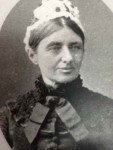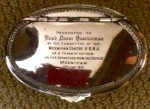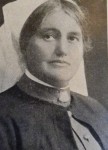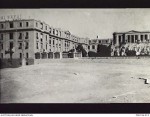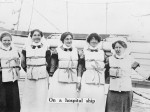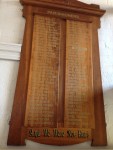QUARTERMAN, Rosa Elizabeth Kate
Rosa Elizabeth Kate Quarterman (1872–1940) served in the Australian Army Nursing Service from 1914 to 1920. She worked initially in hospitals in Egypt until early 1916 when she returned to Australia with invalided and repatriated troops. She was then appointed a matron in the Sea Transport Service, making seven separate journeys in eighteen months on the so-called ‘Black’ or ‘Dark’ ships between England and Australia. Her last trip to Australia was as a patient recovering from severe pneumonia.
Rosa Quarterman was decorated with the Royal Red Cross (2nd Class) for her service.
She is commemorated on the Honour Board at St Peter’s Church, Eastern Hill, East Melbourne with other nurses from the parish who enlisted, and in The Avenue of Honour in Ballarat.
+++
Before the War
Rosa Quarterman was one of ten children (4s, 6d) of English-born John Quarterman (1823–1878) and his Scottish wife Martha (nee Moodie) (1838–1933).
Her father John Quarterman had arrived at Port Phillip (Melbourne) in 1839. Highly enterprising, he built a reputation in stock, wool and stations from the mid 1840s (Age, 2.9.1856, p6). He acquired ever increasing tracts of land in the 1850s including the Wonwondah run near Coleraine (west Wimmera), then Glenmona station in the Castlemaine area in the 1860s and early 1870s.
In the 1870s, he established a business as a stock, station and wool broker, and lived with his family in the large house set in 17 acres on Boundary Rd, Toorak he purchased in 1857. He died there in 1878.
Quarterman was always active in local affairs. He was member of the Victorian Legislative Assembly for Wimmera from 1857 to 1859, and magistrate and local councillor for Gardiner (now Toorak/Stonnington) at the same time, a life member of the Stawell Hospital and Benevolent Asylum, and active in the philanthropic Old Colonists Association. In 1869, he was at the centre of a corruption scandal involving bribery of parliamentarians in return for decisions regarding land titles favourable to large landholders, and spent a night in the debtors’ prison (http://www.parliament.vic.gov.au/re-member/bioregfull.cfm?mid=661).
In 1855, Quarterman married 17 year old Martha Moodie of Wando Dale Estate near Coleraine. The Moodies were well known pioneering settlers in the area (Australasian, 13.7.1901, p8). Her father, Scottish farmer John Moodie, had purchased the large run in 1853 on which he ran sheep and cattle. Martha gave birth to ten children (all of whom survived) between 1855 and 1876, the first at Wonwondah run, the next three at Glenmona, and the remaining six in Toorak near Melbourne. Rosa was the youngest daughter.
Rosa’s father died in 1878, leaving her mother Martha with ten children aged between 4 and 23 and £2400. From a wealthy pastoral family herself, Martha now bought and sold property in her own right. She expanded the family home in Toorak to 12 rooms and rented it out. At the same time she purchased 4000 acres (1600 hectares) near her own family’s run in south west Victoria, and built a substantial complex of homestead and gardens. The property has been described as an ‘unusual example of a selection of land being taken up by a woman in the nineteenth century ... ’ (vhd.heritage,vic.gov.au). She also purchased a home at 4 Canterbury Rd, Toorak where she and some of her unmarried children lived for many years.
Misses Quarterman appeared in Melbourne’s social columns in the 1890s. Only the eldest of the five sisters (Charlotte Margaret, b1858) married. Martha’s second daughter Connie died in 1904 aged 42. Clara (b1867) trained as nurse. She was matron of Camperdown hospital in the early 1900s and later a school matron at Trinity Grammar in Kew and The Hermitage near Geelong. Beatrice (b1869) took up a position as manageress at Moondah, a large country property on the Mornington Peninsula whose owner ‘Squire’ John Grice hosted hunts and entertainments for Melbourne society (www.discovermorningtonpeninsula.com.au). Mabel (Caroline) (b c1866) was a ‘typiste’.
Rosa followed her eldest sister Clara into nursing. She trained at the Melbourne Hospital in Carlton and was then appointed to the staff. In 1904, she was appointed matron of the hospital in Zeehan, south west Tasmania. Zeehan was a thriving town of around 6000 people, enjoying a boom from silver mining. The previous matron had clashed with the hospital board over the appointment of trainee nurses, and Matron Quarterman’s successor was to do the same to the extent of precipitating a royal commission into the hospital in 1912. Quarterman however won over the board, despite some testing moments. The grateful board members presented her and her nurses with Maltese Cross medals for their handling of a typhoid epidemic (e.g. Mercury [Hobart], 9.1.1907, 15.4.1907).
Matron Quarterman left Zeehan in 1911. The subsequent royal commission alluded to her clashes with the board, but her departure was deeply regretted by its citizenry (Examiner [Launceston], 1.6.1911, p5). She returned to Victoria, working briefly for the fledging Bush Nursing Society in and around Meeniyan in South Gippsland (Leader, 27.1.1912, p47). Her appointment was reported in a number of newspapers around the country.
Perhaps tiring of remoteness and/or missing a supervisory role, she moved to Ballarat in 1912 as matron of the hospital there. Her experience in mining and rural communities was considerable and once again she met the approval of both hospital board and community. The board offered her indefinite leave of absence for the duration of the war when she left on active service (Ballarat Star, 13.5.1915, p4).
War Service
Like many nurses’ service records, Rosa Quarterman’s is scant on detail particularly with respect to her early active service. Her application to join the Australian Army Nursing Service is signed and dated 28 November 1914, at which point she had already embarked on the ‘Kyarra’ with medical personnel of 1 Australian General Hospital. Beyond any pull of duty, patriotism or adventure, another factor very likely in play in her decision was the enlistment of her younger brother Guy earlier in November. His age was recorded as 30 (he was 38); Rosa was 42. He was not to embark however until February 1915, by which time his sister had arrived in Egypt.
Rosa Quarterman sailed from Melbourne on the 'Kyarra' on 28 November 1914 with 160 other nurses and medical officers who made up the 1 and 2 Australian General Hospitals. The Royal Victorian Trained Nurses Association gave them a fine farewell (Punch, 26.11.1914). There were other nurses from East Melbourne in the group, including Minnie Hobler and Estelle-Lee-Archer. The seven week voyage with its seasickness, lectures and deckgames was recorded in the diary of Staff Nurse Elsie Cook (Peter Rees, The Other ANZACs: Nurses at War, 1914-1918, pp. 7-11, 15).
'Kyarra' reached Egypt on 20 January 1915. 1AGH was set up in the Heliopolis Palace Hotel, a four story luxury facility in the Cairo suburb of Abbassia.
Quarterman’s period at 1AGH was a time of near continuous high drama. The deluge of casualties evacuated from the Gallipoli peninsula placed enormous physical and emotional demands on the nursing staff which was expanded with reinforcements as the number of beds expanded (see Rees, The Other ANZACS, pp. 44-45, 48-49).
In addition, there was the battle for authority between Principal Matron Jane Bell and 1AGH Commanding Officer Colonel Ramsay Smith that led to the recall of both to Australia in July 1915, a formal inquiry and termination of their appointments (Jan Bassett, Guns and Brooches: Australian Army Nursing from the Boer War to the Gulf War, 1992, pp. 34-39).
These stresses were compounded for Rosa by the news that her brother, Private Guy Quarterman, was reported as wounded and missing in action near Popes Hill at Gallipoli on 26 April. Undoubtedly brother and sister met in Egypt before he sailed for the Dardanelles with his battalion. Rumours that he had been captured proved false, although it was months before he was declared Killed in Action (https://www.aif.adfa.edu.au/showPerson?pid=247784). His body was never recovered.
For at least some of her service in Egypt, Rosa Quarterman was matron of the Helouan Convalescent Hospital (Ballarat Star, 6.10.15). Helouan was 30 kilometres from Cairo and considerably cooler. Like 1AGH, the hospital was in a magnificent hotel (Al Hayat) and capable of holding 1500 patients. The patients were brought from Cairo by motor ambulance or train. Before or during their convalescence, they were deemed fit to return to their unit or unfit and to be repatriated back to Australia. It was taxing for Matron Quarterman and her staff: avalanches of incoming patients, sometimes hundreds at a time, build ups of patients awaiting transport to Australia, then the preparation and discharge of hundreds to their ship. Troops themselves were not necessarily keen to leave: the climate, the relative comfort and the prospect of return to duty resulted in ‘a good deal of disinclination to leave’ (J W Bennett and Percival E Dean, Australian Army Medical Corps in Egypt, www.gutenberg.org [E-book #41911]).
In November 1915, Rosa Quarterman was transferred from Egypt to England, where she was briefly attached to Bagthorpe Military Hospital (a converted workhouse infirmary) in Nottingham. In March 1916, she sailed from Liverpool on the A11 transport ship (‘Ascanius’) bringing invalided troops back to Australia, reaching Melbourne on 30 April.
Rosa spent six months in Australia, presumably reuniting with her family mourning the loss of their son and brother Guy, nursing in a military/base hospital, and taking leave.
In September 1916, she left Australia again, this time as Acting Matron with the No 4 Sea Transport Section. The Sea Transport Section, which was raised in Australia from 1915, was an ‘important innovation in medical evacuation procedures’ (Kirsty Harris, ‘Red Reflections on the Sea: Australian Army Nurses serving at Sea in World War 1’, Journal of Australian Naval History, Vol 6, No 2, p63; see also A G Butler, The Australian Army Medical Services in the war of 1914–1918, vol. 3, Ch14 Sea Transport of Australian soldiers). Each section (ten in all) comprised a medical officer, matron and six nurses, a dispenser, masseur, quartermaster and 16 other ranks, ‘all carefully selected and trained as a team’ (Harris, p63).
Voyages out carried troops from military camps in the various states for the front, as well as civilian and military cargo. Infectious diseases including mumps, measles and pneumonia kept each Sea Transport Section busy and deaths at sea occurred on most trips. Return voyages carried wounded and invalided troops being repatriated home. The skilled Sea Transport Sections served on ships carrying cot cases needing medical attention or troops needing segregation because of infectious disease or mental illness (Butler, p689).
Sea transport was inherently dangerous. The near continuous danger of submarine attack meant devious routes, longer than usual voyages, escorts, life jackets and constant apprehension about attack.
Rosa made four trips on transport ships from Australia to England between September 1916 and April 1918, on the ‘Euripides’, ‘Wiltshire’, ‘Osterley’ and ‘Miltiades’. Each voyage took six to eight weeks at sea over diverse routes, via the Cape of Good Hope, Panama Canal or Suez and Marseilles. Each voyage to England was followed by a fortnight’s leave and attachment to a hospital, usually No 2 Australian Auxiliary Hospital in Southall, the source of many patients for the voyage home.
On at least one occasion, Rosa Quarterman encountered men from Zeehan. Through Sergeant Ern Lee, she conveyed her ‘kindest regards to all her Zeehan friends’ (Zeehan and Dundas Herald, 4.1.1917). He described her as being ‘loved by every Australian soldier who has been under her care ... a splendid woman and a continuous worker.’
Years after the war, Matron Quarterman gave a vivid account of the Sea Transport Section (Argus, 25.4.1936, p17). She remarked that ‘sheer monotony’ made the Section unappealing to many before going on to recall a series of hair raising experiences from her own voyages: being chased by submarines, seeing an escort ship torpedoed, and weathering a furious storm in which seamen were lost overboard. She sailed through ‘sea ... strewn with floating wreckage from sunken ships’ and saw great steel mess anti-submarine barricades at the entrance to harbours. She endured times when life jackets were worn at all times, ‘all very well for slim people’ she commented wryly.
In mid October 1918, Rosa Quarterman was transferred to No 2 Group Hospital at Hurdcott in Wiltshire near Salisbury Plain and site of a large camp and several hospitals. It is not clear if initially she was nurse or patient but on 30 October, she was admitted to the nearby Fovant hospital, ‘dangerously ill pneumonia’ (Rosa Quarterman, Service Record). She recovered and after a period of convalescence was well enough to return, as an invalid, to Australia on 20 December 1918 – five weeks after the armistice was signed.
Rosa had first left Australia on the ‘Kyarra’ in November 1914, four years earlier. In that time, she had served in Egypt and England, and been matron in a medical team highly specialized in the transport of troops to and from Australia and particularly in the care of seriously ill or wounded men.
In 1919, she was awarded the Royal Red Cross (2nd Class) for her services during the war.
After the War
Rosa Quarterman had returned to Australia with at least the after effects of bronchopneumonia. She was 48.
She maintained her registration with the Royal Victorian Trained Nurses Association, but it is not clear if and when she was well enough to nurse full-time or continuously. In 1920 and again in 1924, she applied for support from the Edith Cavell Trust Fund which had been established to assist sick and needy returned army nurses (Edith Cavell Trust Fund, M291, National Archives of Australia. Unfortunately only the index card survives; her applicationsare missing). The Fund granted Rosa £10 after a tonsillectomy in 1920, and £20 because of an attack of debilitating cerebral anemia in 1924. The records show that she was in receipt of a Repatriation pension (£1.18.3 per week in 1920, £1.10.0 per week in 1924). Her address was the family home at 4 Canterbury Rd, Toorak.
Rosa Quarterman recovered sufficiently to take an active role in the Returned Army Nurses Club in Melbourne and to work again.From 1925 she was the welfare sister at the well known department store, Buckley and Nunn. When war broke out again in 1939, she became the tireless president of the store’s branch of the Australian Comfort Fund. She and her committee organised highly successful dances to raise funds and encourage donations of materials for the troops (Age, 18.3.1940, p3, 12.8.1940, p3.)
Rosa Quarterman died on 11 October 1940. The directors of Buckley and Nunn paid tribute to ‘her many years of kindly service’, while the staff remembered her as ‘one who gave of her best in every walk of life’ (Argus, 12.10.1940, p4). She was cremated at the Springvale Crematorium, Melbourne.
She is commemorated on the Honour Board at St Peter’s Church, Eastern Hill, East Melbourne with other nurses from the parish who enlisted, and in The Avenue of Honour in Ballarat.
Thank you to Guy Quarterman for his input, encouragement and photographs.
Janet Scarfe
Adjunct Research Associate, Monash
29.1.2017
Can you help?
Can you correct or provide more information about this person?
Or are you able to help with this history project?
- Family stories and records including photos, documents and memorabilia?
- Stories or information in books, newspapers and on-line?
- Memorial plaques in churches and public places?
- War memorial, church, national and state archives?
If so, please Contact the East Melbourne Historical Society.

